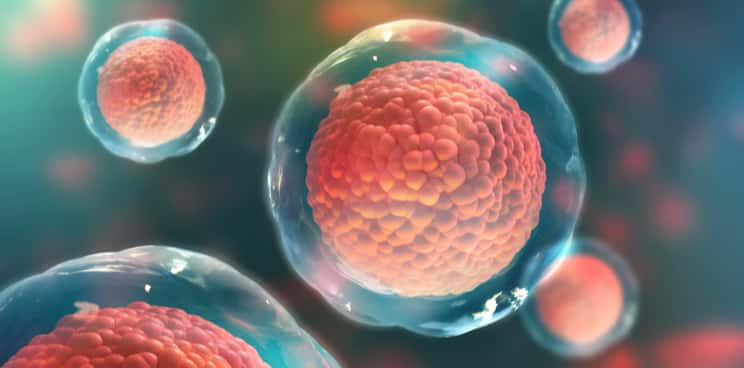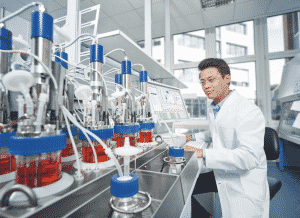Since the turn of the century, stem cell technology has delivered on its promise to transform the healthcare industry, while its applications across different sectors have continued to emerge. Bioreactors, offering improved process control as well as scalability, have been adopted worldwide for stem cell production and cultivation. Join us as we dive into the world of lab-grown meat to see how stem cells are set to revolutionize the food industry as well.
Stem cells are undifferentiated cells that have the intrinsic capacity to self-renew, that is, to divide and develop into different types of cells. Since its discovery in the 1960s, stem cell technology has harnessed the power of stem cells to solve problems in the field of medicine.
The science behind stem cells and their versatile applications
In humans, stem cells are the basic anchor cells out of which all cells in the body originate. They have varying abilities to differentiate into specialized cell types, a characteristic known as potency. Stem cells can be categorized into three types based on their potency.
A fertilized egg is made up of the first type of stem cells, totipotent cells, that possess the ability to be programmed into any cell type, including embryonic and placental cells.
Second are the pluripotent cells, with more restrictions in their capacity to divide as compared to totipotent cells. These cells are also found in the embryo and have the ability to form more than 200 different cell types in the adult body.
Lastly, multipotent stem cells are already committed to forming certain cell lineage types. These cells are commonly found in many tissues in the body, including adult bone marrow, skin, and cord blood.
In research, the generation of embryonic stem cells requires human embryos to be harvested. However, the use of human embryos has triggered a fair share of controversy in stem cell research, causing the field to stagnate.
Due to this, scientists have favored the use of adult multipotent stem cells because of the advantages these cells offer, such as better availability, improved safety, and ease of culturing.

The 2012 Nobel prize-winning discovery of induced pluripotent stem cells – normal cells, like skin cells, which have been reprogrammed to have a stem cell-like pluripotency – has successfully addressed this ethical concern, allowing stem cell research to regain its lost pace.
Stem cell technology was initially applied as cell replacement therapy, which involves transplanting stem cells (hematopoietic) into patients, to aid in leukemia and other disease treatments.
Since then, numerous stem cell applications have been tested worldwide. These include immunomodulatory applications using mesenchymal stem cells, the replacement of body parts like kneecaps leveraging tissue engineering, and the development of disease models (in place of using animal models) for drug discovery.
A sustainable solution: lab-grown meat
One such interesting stem cell technology application is lab-grown meat, which refers to meat that is comprised of animal cells but grown outside of the animal in controlled laboratory settings.

“Cell-based biotechnology is being used to replace traditional animal-derived products, such as meat, seafood, or leather. Lab-based meat is produced using tissue culture and is identical to conventional livestock meat,” said Philipp Nold, Application Specialist for Stem Cells at the Eppendorf Bioprocess Center in Germany.
Explaining how cultured meat helps address current environmental and sustainability challenges, Nold continued: “The world population is projected to grow from seven to 10 billion from 2016 to 2050, with the demand for food set to increase by over 70% in this period. We need to expand capacity to meet that increased demand for food.”
“Simultaneously, we have to manage ongoing effects of climate change that come with livestock methane emission, as well as the land and water use involved. Innovative technologies are needed to face this challenge and cell-based meat offers a viable solution.”
Lab-grown meat is also healthier than meat procured from industrial farming. It eliminates the need for animal farms, providing the two-fold benefit of ensuring animal welfare as well as making the food antibiotic-free.
To produce cultured meat, stem cells are isolated via simple biopsy from a living animal – chosen based on the meat being produced – and then cultured in vitro, without harming the animal.
By adding specific factors into the media, the cells are then stimulated to differentiate into muscle or fat, or other types of cells. Following this, they are harvested and assembled into tissue that resembles meat with the help of tissue engineering.
The challenges with scaling up cultured meat for food supply
The main challenge with producing lab-grown meat today lies in the expenses involved in scaling up the production to meet the growing demand for food.
The volumes of stem cells currently being produced are optimized for cell therapy applications, which are already deemed expensive. When it comes to manufacturing cells fit for food supply, the volumes required are exponentially higher, as are the costs involved.
Another challenge is optimizing the taste and nutritional value of lab-grown meat. Further research in profiling the cells is warranted for producing more complex meats like a steak which has a more intricate texture and flavor profile versus a hamburger patty, for example.
Despite such challenges, our understanding of stem cells and their cultivation has been rapidly evolving and has continued to grow after lab-grown meat was first unveiled in 2013.
Therefore, gaining insight into how lab-grown meat can be brought to market is just a matter of time, assured Nold. “When something starts getting mass-produced, the costs of the technology involved will also fall.”

In line with this prediction, the sophistication of the technology to produce stem cells – and in turn lab-grown meat – has already evolved greatly. Historically, a manually controlled set-up consisting of cultivation platforms like flasks was used for stem cell cultivation.
“Today, different bioreactor types have been widely adopted to enable standardized and reproducible stem cell cultivation. Bioreactors not only offer a monitored environment to control critical process parameters like pH, dissolved oxygen, and temperature for optimized cell growth, but they also enable efficient and cost-effective upscaling of stem cell production,” elaborated Nold.
The path to commercializing lab-grown meat
Leveraging bioreactor design and optimizing the scale-up process may hold the key to bringing cultured meat to market.
As a company that specializes in instruments, consumables, and services for bioprocessing and a host of other life science applications, Eppendorf helps customers in the stem cell technology space achieve the successful scale-up of their products.
Eppendorf’s bioreactors utilize a stirred tank technology creating an optimal environment that maintains stem cell potency and viability.
“Our systems offer precise control over different types of parameters and processes, aided by automated monitoring. Even the smallest Eppendorf bioreactors are constructed such that they can implement industry-standard controls.”
“This allows our customers to first optimize parameters in our smaller volume systems during research and development stages, and then smoothly scale to large-scale production volumes,” explained Nold.
The advances in bioprocessing technology and the growing awareness of the benefits of cultured meat are helping to increase the social acceptance of lab-grown meat consumption.
“Cultured meat has a bright future, potentially at tables in high-end restaurants, even moving into supermarkets, ultimately,” said Nold. “Over the next few years, with increasing regulatory guidance, lab-grown meat will become a sustainable alternative to existing options and Eppendorf is excited to play a part in making that a reality.”
To read about how stem cell technology and its powerful applications are transforming the world around us, click here to access Eppendorf’s e-book.
Visit this page to learn more about how Eppendorf’s single-use stirred tank bioreactors can help you upscale your stem cell production.
Images via Shutterstock.com and courtesy of Eppendorf.





